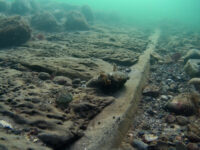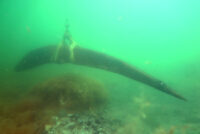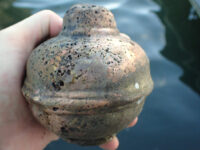 Marine archaeologists have discovered the wreck of the Delmenhorst, a Danish warship lost in the Battle of Fehmarn in 1644. It is the last of the ships from that battle to be found. It was discovered during an archaeological survey in advance of construction of the Fehmarn Belt underwater tunnel connecting Denmark and Germany. The wreck was in shallow waters — just 11 feet under the surface — 500 feet off the southern coast of Lolland near the town of Rødbyhavn.
Marine archaeologists have discovered the wreck of the Delmenhorst, a Danish warship lost in the Battle of Fehmarn in 1644. It is the last of the ships from that battle to be found. It was discovered during an archaeological survey in advance of construction of the Fehmarn Belt underwater tunnel connecting Denmark and Germany. The wreck was in shallow waters — just 11 feet under the surface — 500 feet off the southern coast of Lolland near the town of Rødbyhavn.
The Delmenhorst was deliberately grounded by Danish forces towards the end of the battle when it became clear that Sweden was winning. They wanted to use its heavy cannon to defend the harbour of Rødbyhavn, but the plan failed when the Swedes set fire to one of their ships and sailed it into the Delmenhorst. The Danish warship caught fire and sank.
The Battle of Fehmarn took place during the Torstenson War between Sweden and Denmark-Norway. The war began in December 1643 with a Swedish invasion of the Danish Duchy of Holstein and ended in the humiliating defeat of Denmark in August 1645. King Christian IV of Denmark lost an eye in the war and Denmark-Norway lost piles of revenue, territories and its domination of the Baltic Sea.
 The wreck was first spotted with side-scan sonar. Divers explored the wreckage and found a 20-foot section of keel, charred timbers, the bottom of the hull and ballast stones. Scattered debris around the remains of the ship included the melted, cracked and exploded remains of bronze cannon, evidence of the destructive powder of the Swedish fireships.
The wreck was first spotted with side-scan sonar. Divers explored the wreckage and found a 20-foot section of keel, charred timbers, the bottom of the hull and ballast stones. Scattered debris around the remains of the ship included the melted, cracked and exploded remains of bronze cannon, evidence of the destructive powder of the Swedish fireships.
A few objects and samples have been raised from the wreck site, but the  bulk of it will remain where it is. Because it is in such shallow water making it unhealthily accessible to tourists, the remains of the ship will be buried in sand for its own preservation. Archaeologists from the Viking Ship Museum have taken 30,000 photos of the wreck that will be used to create a digital 3D model that can be studied and exhibited at the museum without disturbing the site itself.
bulk of it will remain where it is. Because it is in such shallow water making it unhealthily accessible to tourists, the remains of the ship will be buried in sand for its own preservation. Archaeologists from the Viking Ship Museum have taken 30,000 photos of the wreck that will be used to create a digital 3D model that can be studied and exhibited at the museum without disturbing the site itself.
The House of Oldenburg of North German origin rose to prominence when Count Christian I of Oldenburg was elected as King of Denmark in 1448, of Norway in 1450 and of Sweden in 1457.
Count Jakob of Oldenburg-Delmenhorst (born in 1463) was famous for his acts of piracy. He had spent time in Bremen at the archbishop’s court, but immediately joined his uncle Count Gerd after coming of age and began to attack Hanseatic merchants.
Delmenhorst became Count Gerd’s base for raids and battles with the Bremen clergy. In 1482, when Delmenhorst had to surrender to Bremen, Jakob emigrated to the court of his cousin, the Danish King Hans. The Danish king was apparently unable to support him politically, but managed to get him a ship, which Jacob allegedly intended to take on a journey to France.
In reality, however, Jakob engaged in piracy and took brutal revenge on Hanseatic sailors who fell into his hands. The circumstances of his death are unclear; he allegedly fell ill with scurvy and died in the summer of 1484, barely 20 years old, in a Swedish port town. Rather unclear seems to me, why later in the 17th century, the Danish named one of their vessels ‘Delmenhorst’.
:hattip:
To conclude this post of mine, here the band “Element of Crime” with a country song –with very stereotypical country song lyrics– about a small town in Lower Saxony, “Delmenhorst”, here you go: youtube.com/watch?v=c-2VJoYUw3g